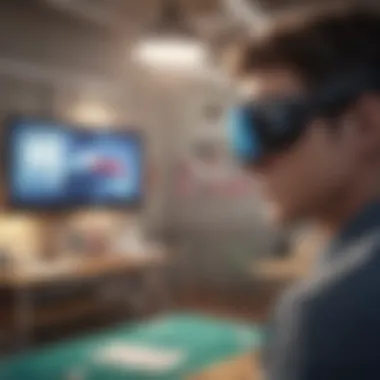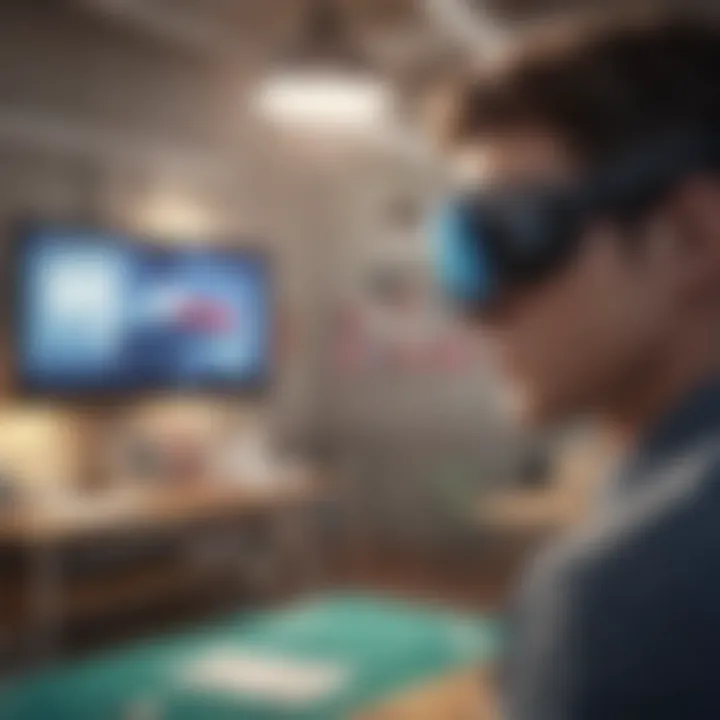Mixed Reality vs. Augmented Reality: Understanding Differences


Intro
In today's rapidly evolving technological landscape, distinguishing between mixed reality and augmented reality has become increasingly paramount. For many professionals, especially those in investment or technology sectors, understanding these two realms is more than just academic; it has real-world implications. As they dive deeper into the functionalities and applications of these technologies, they find endless possibilities that can revolutionize the way we interact with digital content.
Both mixed reality (MR) and augmented reality (AR) represent unique methods of integrating digital information with the real world. However, the nuances that set them apart are often overlooked. It’s essential for investors and professionals to grasp these distinctions to inform their decisions, whether they are looking to invest in new technologies or applying them within their own enterprises. By the end of this discussion, readers will have a clearer sense of how to navigate the intricate mesh of these two paradigms.
Investment Terminology Breakdown
Understanding the terminology in the realm of mixed and augmented reality is like having a map when venturing into unfamiliar territory. Knowledge of key terms enables investors and professionals to make informed choices.
Key Terms Explained
Mixed Reality: This is the fusion of the real and the virtual worlds in such a way that they can coexist and interact in real-time. Users can engage with both digital and physical objects as if they were part of the same environment. An example of mixed reality can be seen with Microsoft HoloLens, where you might overlay a digital model of a building on the actual site.
Augmented Reality: In contrast, augmented reality primarily enhances the real-world experience without fully integrating it with digital components. Think of smartphone apps like Snapchat filters or Pokémon Go, which place characters in real-world settings but do not let these characters interact with physical objects.
How to Differentiate:
- Interaction: In mixed reality, users can manipulate virtual objects as if they were real. In augmented reality, the interaction is typically limited to viewing.
- Environment Integration: MR requires a sophisticated understanding of the environment to create experiences, while AR can function with relatively simple visual overlays.
Common Misconceptions in Investing
One of the biggest misconceptions is equating augmented reality and mixed reality simply as different names for the same technology. In reality, they serve different purposes and potential markets. This misunderstanding can lead to poor investment choices or misguided strategies, particularly if one assumes a greater market potential for a technology simply due to higher media visibility.
Another misconception is believing that AR is only for gaming or entertainment, overlooking its substantial implications in education, healthcare, and industrial applications, where its utility is vast and varied.
Investing in mixed reality and augmented reality requires more than just understanding the buzzwords; it’s crucial to grasp the essentials of how each technology can be applied in business contexts.
Financial Product Reviews
As these technologies gain traction among investors, a closer look into specific products in the realm of mixed and augmented reality offers insights into their market viability.
In-Depth Product Analysis
- Magic Leap One: This mixed reality headset combines realistic graphics with the user's environment. It is particularly geared toward enterprises for training and design.
- Google Glass: Though primarily known as a pioneer in AR, its applications span from healthcare to logistics, indicating its flexible potential.
Pros and Cons of Each Offering
- Magic Leap One
- Google Glass
- Pros:
- Cons:
- Strong enterprise focus with customizable solutions.
- High-quality spatial computing capabilities.
- Higher price point may put off smaller companies.
- Limited consumer market penetration.
- Pros:
- Cons:
- Established brand history and recognition.
- Wide range of applications from medical to retail.
- Initial consumer response was lukewarm.
- Privacy concerns remain a significant issue.
Understanding the nuances between mixed reality and augmented reality not only clarifies their unique attributes but also prepares investors and professionals to leverage these advancements effectively in their respective domains. Navigating through the underlying technologies and concepts can shed light on the path forward in this exciting and transformative arena.
Understanding Mixed Reality and Augmented Reality
In a world where technology evolves at breakneck speed, the lines separating different fields can blur significantly. Understanding mixed reality and augmented reality is not just a tech-savvy endeavor; it’s a crucial element for anyone aiming to capitalize on the upcoming digital frontier. With these technologies reshaping industries from retail to healthcare, knowing the unique capabilities and implications of each can position investors and professionals advantageously in the market.
People often toss around terms like "mixed reality" and "augmented reality" as if they are interchangeable, but they hold specific nuances. Mixed reality melds the physical with the digital in a way that allows for interaction between the two realms. On the other hand, augmented reality primarily enhances the real world with digital information. Recognizing these distinctions is vital for making informed decisions about technology investments and applications.
Definitions and Fundamental Concepts
The basis of any serious discussion about mixed reality versus augmented reality lies in their definitions.
Augmented Reality (AR) enhances real-life experiences by layering digital elements onto the physical world. Think of it like wearing glasses that superimpose information upon your field of vision. A straightforward example is how apps like Pokémon GO allow users to interact with animated characters that appear in their actual surroundings.
Mixed Reality (MR) takes this a step further by enabling real-time interactions between physical and digital objects. Microsoft’s HoloLens serves as a hallmark example, allowing users to manipulate digital components as if they were part of the real world, merging reality and virtual space seamlessly.
- Mixed Reality: Merges real and virtual worlds for interaction.
- Augmented Reality: Enhances actual environments with additional information.
Historical Context and Evolution
The journey of mixed reality and augmented reality is a fascinating one. Going back to the late 1960s, computer scientist Ivan Sutherland laid the groundwork for augmented reality with his revolutionary work on head-mounted displays. These displays, though primitive by today's standards, represented the first step toward building a framework for overlaying digital content onto the real world.
As technology advanced, AR saw significant developments in the 1990s, with projects like Virtual Fixtures from the U.S. Army, which utilized computer-generated imagery to assist in real-world tasks.
Meanwhile, mixed reality, which evolved from AR, began gaining traction around the 2000s. Companies started combining elements from both fields to create environments that offered interactive experiences that were not previously possible.
The growth was exponential, especially with the improvement of hardware and processing power during the 2010s, where smartphones began playing a significant role in making AR accessible to the masses through applications and games.
With advancements continuing, understanding these historical roots can provide deep insights into future developments. Ultimately, these technologies are stepping stones towards an even more integrated digital experience.
"Technology is nothing. What’s important is that you have a faith in people, that they’re basically good and smart, and if you give them tools, they’ll do wonderful things with them.” - Steve Jobs


Key Differences Between Mixed Reality and Augmented Reality
Understanding the differences between mixed reality (MR) and augmented reality (AR) is vital for stakeholders aiming to navigate the ever-evolving landscape of digital technologies. While both concepts enrich user experiences by blending the real and digital worlds, they do so in distinct ways. This understanding can help investors, professionals, and decision-makers consider the implications of each technology for its specific applications, and provide frameworks to evaluate potential returns on their investments.
Technological Foundations
Hardware Requirements
The hardware requirements for MR and AR diverge significantly. Augmented reality typically leverages mobile devices and simple wearables, making it more accessible than mixed reality, which often demands sophisticated equipment like Microsoft HoloLens or Magic Leap One.
A key characteristic of hardware for mixed reality is its capability to track and analyze the user’s environment in real-time. This creates a more immersive experience that's responsive to user actions and surroundings, providing a more complex interaction. However, the high cost associated with these advanced setups can be a barrier for many organizations. While AR requires less resource-intensive devices, it limits the depth of interaction and immersion.
Some unique features of hardware in AR include compatibility with a broader range of consumer technology, such as smartphones. This accessibility makes AR a practical choice for various sectors, catering to a wider audience yet lacks the seamless integration offered by MR. Hence, the choice largely depends on the intended use case and budget constraints.
Software Frameworks
The software frameworks that support MR and AR also exhibit notable differences. In the realm of augmented reality, applications often run on platforms like ARKit for iOS and ARCore for Android, both focusing on overlaying information on the real world. These platforms simplify the development process, drawing in a larger pool of creators.
On the other hand, mixed reality software often requires environments that can process spatial mapping and engage with the physical environment in richer ways, like Unity 3D or Unreal Engine. The advantage here is the potential for more engaging content that interacts with users and their surroundings in a meaningful manner. However, the complexity of developing for MR software can deter smaller companies or independent developers.
This complexity can create limitations in terms of available content for MR compared to the extensive library of AR applications. Consequently, the decision on which software framework to use hinges on the specific functionalities desired and the expertise of the development team.
User Interaction and Experience
Realism and Integration
When discussing realism and integration, we see stark contrasts. Mixed reality provides a more authentic sensory experience by combining real and virtual elements in a cohesive manner. This is because MR focuses on creating lifelike interactions with virtual objects, allowing users to manipulate and engage with them as if they were physical entities. This integration makes it particularly useful in fields such as architecture, where realistic visualizations enhance understanding and communication.
In contrast, augmented reality is often considered less interactive. AR primarily enhances the real world with digital overlays without deeply integrating into the physical environment. While this can add value in situations like navigation or information display, it often doesn’t achieve the same level of immersion. This sometimes leads to superficial experiences where the virtual content lacks substantive interaction.
User Engagement Levels
Finally, let’s examine user engagement levels. Mixed reality tends to offer deeper engagement because it invites users into a participatory role, enhancing attention and involvement. Users can interact directly with virtual elements, thus creating a sense of presence and investment. This depth of engagement can lead to better retention of information and a richer overall experience.
Conversely, user engagement in augmented reality can be described as more passive, where users consume overlaid information without substantial interaction. Although AR can be very engaging, especially when it promotes active participation in games or educational scenarios, the level of engagement often falls short compared to MR. This discrepancy can affect user satisfaction and the efficacy of AR applications, particularly in educational or training environments.
In summary, the distinctions between mixed reality and augmented reality are critical for understanding how each technology can be utilized effectively. The technical requirements, interactions, and user experiences underline the necessity of tailored approaches for businesses looking to capitalize on these innovations.
Applications of Augmented Reality
Augmented Reality (AR) is changing the game across various sectors, crafting experiences that blend the physical and digital worlds in ways that might boggle the mind. In this section, we examine the significance of AR applications in today’s tech landscape, shedding light on unique elements, benefits, and considerations.
AR isn't just a fun gimmick; it’s becoming a pillar for innovation in many industries. It elevates user engagement, streamlines processes, and transforms traditional practices into something extraordinary. Specifically, various fields such as retail, education, and entertainment are finding new life through AR technologies, leading to investment opportunities and business growth.
Retail and E-commerce Enhancements
The retail industry has embraced AR with open arms, and for good reason. Imagine walking into a store where you can visualize how a piece of furniture fits into your living room without leaving your couch. That's AR at work, effectively bridging the gap between a digital reflection and the real world.
- Virtual Try-Ons: Tech like the Sephora Virtual Artist app allows customers to try on makeup virtually, reducing the need for testers and making the shopping process more hygienic.
- Interactive Displays: Retailers can use AR to create interactive displays that engage customers. For instance, Zara’s augmented reality app showcases clothing on virtual models, enhancing the shopping experience.
This type of engagement leads to not just satisfying experiences, but also higher conversion rates. Studies show AR can increase customer spending by as much as 30%!
"AR technology has the power to radically change consumer purchasing behavior and decision-making processes."
Educational Tools and Resources
In the realm of education, AR transforms traditional learning methods into captivating, interactive experiences. Textbooks that come alive with animations or simulations can enhance understanding in a way that a static page simply can't.
- Interactive Learning: AR applications like Merge Cube enable students to hold and interact with 3D models, from human anatomy to historical artifacts, turning abstract concepts into tangible knowledge.
- Remote Learning Aids: In a world where online classes are increasingly common, AR can provide critical support. It allows students to collaborate in augmented spaces, enriching remote learning scenarios.
These innovations don’t just enhance learning; they foster deeper comprehension and retention of material. When students see complex subjects visually represented, it paves the way for greater engagement and a love for learning.
Gaming and Entertainment
The gaming industry is perhaps the most recognized field benefiting from AR innovations. Pokémon Go, a game that had folks wandering city streets in search of digital creatures, demonstrated how AR can re-define entertainment.
- Immersive Gameplay: Games that integrate AR technology provide experiences where players can interact with their environments, creating a more engaging and fascinating experience.
- Enhanced Storytelling: AR in gaming can add layers to the narrative. For instance, users can unfold stories through their real-world context, making gameplay feel deeply personal and relevant.
The fusion of gaming with AR doesn't just entertain but also propels new business models and revenue streams. The integration of AR leads to opportunities not only for developers but also for investors who recognize its potential.
In closing, the application of AR in various sectors is more than a fleeting trend; it’s a transformative force that molds user experiences, drives engagement, and opens new channels for investment. As technology continues to develop, the implications of AR will likely grow even more significant.
Applications of Mixed Reality
In an era driven by rapid technological advancements, mixed reality stands at a vital crossroads between direct interaction and digital enhancement. Its applications have moved beyond mere entertainment, potentially reshaping various sectors from manufacturing to healthcare. Understanding these applications is essential for stakeholders wanting to unlock new value and gain a competitive edge.
Industry and Manufacturing Solutions
In the context of industry, mixed reality is poised to revolutionize workflows. Thanks to the merging of digital landscapes with physical environments, workers can gain instant access to vital information without their hands leaving the task at hand. Picture an assembly line technician. Instead of flipping through manuals or navigating screens, they can wear smart glasses, allowing the system to overlay instructions directly onto the equipment. This method cuts down error rates and speed up processes.
Benefits include:
- Error Reduction: Real-time data can reduce mistakes dramatically.
- Training Enhancement: New hires can learn directly from a user-friendly interface that guides them through complex machinery.
- Collaboration Abilities: Multiple users can engage in the same mixed reality environment, regardless of location, fostering teamwork.


Adopting this technology, however, is not merely about hardware. The software solutions need to synchronize perfectly with existing systems to ensure seamless implementation. Finding that synergy is crucial for companies aiming to adopt mixed reality into their operations.
Medical Simulations and Training
In healthcare, mixed reality is transforming training methodologies. Traditional training often involves theoretical learning, making it challenging to grasp practical applications. With mixed reality, medical students can enter environments that replicate real-life scenarios.
For instance, imagine a surgical trainee who can practice on a virtual patient, complete with real-time feedback and various complications that could arise during an actual procedure. Such immersive training helps in fine-tuning the skills needed to navigate complex situations safely.
Key aspects are:
- Patient Safety: Trainees can make mistakes in a risk-free environment, learning invaluable lessons without the danger of harming actual patients.
- Skill Mastery: Repetition is important; mixed reality allows practitioners to hone their techniques consistently.
- Interdisciplinary Training: Surgeons can collaborate with anesthesiologists or nurses in virtual settings, enhancing team dynamics before they ever set foot in a theater.
Investors should take note—there is an expanding market for medical mixed reality, grounded in the increasing need for both skilled professionals and patient safety technology.
Architectural Visualization
When it comes to architecture, the combined elements of mixed reality allow architects and clients to experience designs even before the first brick is laid. By wearing headsets or using mobile devices, clients can walk through a 3D representation of their future property, providing a tangible feel that flat blueprints and renderings can never offer. This interaction not only makes the process more engaging but often eliminates misunderstandings.
The use of mixed reality in architectural design facilitates a better grasp of space, dimensions, and overall aesthetics.
Advantages include:
- Client Engagement: Clients can visualize modifications in real-time, streamlining the feedback process and enhancing satisfaction.
- Design Iteration: Architects can swiftly adapt designs based on viewer reactions, refining concepts on the spot.
- Presenting a Cohesive Narrative: Projects can be sold more effectively, as prospective buyers can envision themselves in the space.
When looking toward the future, the potential for mixed reality in architecture appears bright. As technology becomes more accessible, those in the field should consider the innovative capabilities this brings.
"Incorporating mixed reality into practices is not just about keeping pace with technology; it’s about defining a new era in interaction and design."
Engaging with these applications of mixed reality will no doubt drive investments and application considerations in expanding sectors. Their potential has yet to be fully realized, making them an essential focus for any entities looking to stay ahead in an increasingly competitive environment.
Future Directions in Mixed Reality and Augmented Reality
The landscape of technology is constantly evolving, and the domains of mixed reality and augmented reality are no exception. Understanding the future directions in these fields is crucial not only for tech enthusiasts but especially for investors and professionals aiming to navigate the complexities of this digital terrain. Innovations in these areas promise not just enhancements in user experience but could also reshape entire industries, making it essential to keep a keen eye on emerging trends and the challenges being faced.
As both mixed reality and augmented reality technologies rapidly advance, there are specific elements that stakeholders need to consider:
- Integration with daily life: Future iterations of these technologies aim to seamlessly integrate into day-to-day activities, enhancing how we learn, shop, and communicate.
- Market potential: The projected growth in this sector suggests substantial financial opportunities, underscoring the importance for investors to understand market trends.
- Collaborative experiences: There will be a shift from individual experiences to more collaborative and shared environments, changing the nature of user interaction.
By focusing on these factors, individuals and organizations can better position themselves to harness the capabilities of mixed reality and augmented reality.
Emerging Trends and Innovations
The advancements in mixed reality and augmented reality are beginning to draw a lot of attention. Here are some key trends that investors and professionals should monitor:
- Artificial Intelligence: The influence of AI is becoming more pronounced, aiding in creating smarter environments that react and adapt to users’ behaviors.
- Wearable Technology: Devices like Microsoft HoloLens and magic leap have begun to blur the lines of physical and digital realities and will likely continue to evolve.
- 5G Connectivity: The roll-out of 5G technology is expected to enhance the application of AR and MR by providing fast data transfer rates, allowing for more immersive experiences without lag.
- User-Centered Design: There's an increasing emphasis on creating user-friendly interfaces that make these technologies accessible for a broader audience.
In addition, mixed reality applications are projected to penetrate more into fields like healthcare, manufacturing, and education, providing invaluable solutions to real-world problems.
Challenges and Barriers to Adoption
Despite the promising outlook, several challenges and barriers persist in the adoption of mixed reality and augmented reality technologies:
- Cost of Implementation: The initial financial outlay for hardware and software can be substantial, making it difficult for some organizations to justify expenditure, especially smaller firms.
- User Acceptance: There's a learning curve associated with adapting to new technologies. Some users may find it hard to embrace such substantial shifts in how they interact with their environments.
- Privacy and Security: As data privacy issues loom large in the digital age, the potential for misuse in AR applications raises concern among users.
- Infrastructure Readiness: Not every region has the infrastructure in place to support high-quality AR and MR experiences, limiting their reach and effectiveness.
This mix of opportunities and challenges adds layers of complexity for decision-makers. Evaluating these factors comprehensively will determine how effectively organizations can invest in and utilize these transformative technologies going forward.
"The success of mixed reality and augmented reality will depend not just on technical advancements but on addressing social and ethical implications head-on.”
As we look ahead, it’s evident that future directions in mixed reality and augmented reality are rife with potential and challenges that must be navigated carefully by all stakeholders involved.
Investment Considerations in Mixed Reality and Augmented Reality
Investing in technologies like mixed reality (MR) and augmented reality (AR) is a topic that transcends mere curiosity. In an era where digital transformation is the mantra, discerning the investment landscape in these fields is crucial. There’s a considerable amount of potential locked away in these platforms, not just from a technological standpoint but also from a financial one. Investors and professionals often jostle to find the correct angle to evaluate these emerging technologies, grasping at the delicate balance between reward and risk.
The implications of MR and AR investments extend beyond traditional financial metrics. They open doors for innovative solutions across various sectors, including healthcare, education, and retail. Recognizing the unique characteristics of these technologies can lead to informed decisions and strategic investments. As the industry grows, staying ahead of trends becomes essential to ensuring investments yield fruitful returns.
Market Potential and Growth Prospects
The market potential for MR and AR is nothing short of exciting. According to various reports, these technologies are on the brink of witnessing explosive growth, with projections suggesting multi-billion dollar revenues in the next few years. The rising consumer demand for immersive experiences is a driving force behind this expansion.
- Diverse Applications: Whether it's AR in marketing campaigns, MR in healthcare training, or immersive gaming experiences, the landscape is ripe for exploration.
- Increased Accessibility: As technology advances, making MR and AR more accessible to everyday users becomes a reality, further propelling market growth.
- Investment Trends: Major corporations such as Google, Microsoft, and Facebook are investing heavily in AR and MR, signaling investor confidence in the potential future returns.
The appetite is growing strong for this fascinating realm, and it’s shaping up to be a cornerstone of future technology.
Evaluating Investment Opportunities
When it comes to evaluating investment opportunities in MR and AR, a nuanced approach is needed. Understanding the landscape involves looking beyond glittering technologies to assess the groundwork that makes these innovations possible.
Key Players and Contributors
Key players in the MR and AR domain play a substantial role in shaping market trajectories. Companies such as Niantic, famous for its Pokémon GO, and Magic Leap, with their advanced MR headsets, stand out as pioneers. Their contributions have set the stage for future developments.


- Innovation Capacity: Key players are often characterized by their ability to innovate and adapt rapidly. Their agility allows them to navigate changing market demands, positioning them as beneficial choices for investors.
- Unique Offerings: Each player has a unique value proposition that can set them apart from the crowd. This can make them appealing options for those looking to invest.
- Market Influence: The impact these companies have on the market cannot be overstated. Their successes often lead to increased investor interest across the board, amplifying growth potential in related technologies.
Risk Assessment
Conducting a detailed risk assessment is not just a formality; it's a necessity. Understanding potential pitfalls helps investors navigate the uncertain waters of MR and AR investments.
- Market Volatility: The tech sector is inherently volatile, and MR and AR are no exception. This characteristic means potential investors need to be proactive in evaluating what this volatility may mean for return on investment.
- Technological Hurdles: Despite the promise, both MR and AR still face issues such as user adoption and technology integration. Addressing these challenges is crucial for sustained growth.
- Economic Climate: Changes in the economic environment can impact funding availability for innovative projects. Investors need to stay informed about broader financial trends that may affect their investment opportunities.
Assessing risk holistically can shine a light on what risks are worth taking and which ones are best left behind. In the cutting-edge world of mixed and augmented reality, a comprehensive understanding of both the potential rewards and the inherent risks will empower investors and professionals to make informed choices that resonate beyond immediate profitability.
Ethical Considerations and Privacy Issues
In today's rapidly evolving tech landscape, the discussion around ethical considerations and privacy issues in augmented and mixed reality holds significant weight. As these technologies become more prevalent in various sectors, understanding the ethical implications is crucial for investors, professionals, and end-users alike. The balance between innovation and privacy is delicate; hence, it is vital to address these concerns head-on to foster trust and responsible usage.
Data Privacy in Augmented Reality Applications
Augmented reality brings remarkable enhancements to user experiences, allowing digital information to overlay the physical world. However, this innovative advancement also invites scrutiny regarding data collection and user privacy. AR applications often require access to location data, personal information, and even the device’s camera.
Mind you, this is not just about obtaining data; it’s about how responsibly that data is used. Users frequently don't realize the extent of data collection involved in using AR apps. Companies should prioritize transparency about what data is collected and how it’s utilized. Here are some important points in this context:
- Informed Consent: Users must know exactly what they agree to when downloading an app. Clarity in consent forms can go a long way.
- Data Security: Keeping user data secure is imperative. Breaches not only risk user trust but may also lead to legal complications.
- User Control: Giving users control over their data, such as the ability to opt-out of data collection, enhances trust and engagement.
This approach is not just ethically sound; it's critical for sustaining user trust in AR applications. Without it, users may shy away from engaging with these technologies. Besides, with regulations like the General Data Protection Regulation (GDPR) in Europe and the California Consumer Privacy Act (CCPA) in the U.S., companies must be on their toes to comply with the law or face hefty penalties.
Ethical Implications of Mixed Reality Environments
Mixed reality environments bridge the gap between the physical and digital realms, melding real-world objects with virtual content. This conjures a new set of ethical dilemmas. The immersive nature of mixed reality can influence user behavior, perceptions, and expectations in profound, often unpredictable ways. Consider these elements:
- Content Creation: The line between reality and virtuality becomes blurred. Misleading or harmful content can affect users significantly. Developers should consider the potential repercussions of their creations.
- User Manipulation: There's an ethical concern regarding how mixed reality can exploit emotional and cognitive vulnerabilities. Companies must strive to create enriching experiences that do not manipulate feelings or actions unduly.
- Accessibility: Inclusivity is vital. Not everyone will have equal access to mixed reality technologies. Therefore, ensuring that these tools are accessible to a broader audience is not merely a best practice—it’s an ethical obligation.
From educational settings to complex healthcare simulations, the implications are wide-ranging. Ethical frameworks need to be established and evolved continuously as mixed reality technology progresses, allowing for flexible yet firm ethical boundaries.
"Ethics cannot be for just a select group of people; it needs to be the baseline for everyone operating in the mixed reality space."
Diverse Perspectives on Mixed Reality and Augmented Reality
In the rapidly advancing fields of mixed reality (MR) and augmented reality (AR), understanding diverse perspectives is pivotal. These technologies are not merely technological advancements but also reflect societal and cultural shifts in how we interact with digital and physical environments. Recognizing varied viewpoints allows us to appreciate the impact these technologies have across different domains, from emotional responses of users to strategic concerns of industry professionals.
For investors and financial advisors, gauging user sentiments is paramount. User feedback can indicate market readiness and adoption rates, which are essential for evaluating the potential return on investment in these technologies. Understanding the perspectives of casual users can provide insights into usability and accessibility, while feedback from specialized sectors can shine a light on specific applications that are proving successful or facing roadblocks. Thus, diverse perspectives enable stakeholders to navigate the landscape more effectively, making informed decisions based on real-world implications rather than assumptions.
Additionally, the contrast between user experience and expert insight highlights different facets of the same technology. While users might emphasize ease of use or engagement, experts often delve into the technicalities, exploring challenges, achievements, and future developments. This broad spectrum of views ultimately enriches our comprehension, allowing for a well-rounded evaluation of MR and AR's significance in today’s digital ecosystem.
User Sentiments and Feedback
User sentiments around mixed reality and augmented reality can provide a revealing window into the overall effectiveness and appeal of these technologies. Feedback from everyday consumers tends to be visceral; it stems from their direct experiences. Some users may report feelings of wonder when they see digital overlays enhancing their physical worlds, like using the IKEA Place app to visualize how a piece of furniture would fit in their homes.
However, there's also a share of skepticism. Users have raised concerns regarding issues like privacy and the potential for digital distractions in an already cluttered world. For instance, studies suggest that many individuals worry about how their data might be used in AR applications. Balancing praise and criticism provides a more nuanced understanding of user experiences that businesses must consider when developing their products.
Key Takeaways
- User feedback reveals both excitement and concerns, showcasing the duality in perceptions.
- Engagement levels can vary significantly; some users find the experiences incredibly immersive, while others may feel overwhelmed or even alienated by excessive digital content.
- Conducting focus groups or leveraging social media insights can illuminate these sentiments further, fostering a deeper connection between technology creators and users.
Expert Opinions and Insights
Expert opinions bring a different ballgame to the table. Professionals in the field of mixed reality and augmented reality often look at the broader implications of these technologies beyond user experiences. Experts tend to focus on aspects like technological feasibility, scalability, and the ethical dimensions of MR and AR applications. For instance, leading figures like Jon Favreau, a director who has been a vocal proponent of virtual production techniques, assert that MR can fundamentally change how stories are told in media.
Additionally, industry leaders emphasize the operational challenges faced by companies aiming to implement these technologies. They detail financial barriers, technological hurdles, and the necessity of conducting rigorous testing before full-scale deployment. As noted by experts, an approach leaning heavily into data security and user privacy will be crucial as these technologies evolve, highlighting the importance of ethical frameworks in their adoption.
"The true promise of augmented and mixed realities lies in their potential to blend our digital and physical worlds seamlessly, but that blend must be managed carefully with respect for user agency and privacy."
— Dr. Linda Smith, AR technology researcher.
In summation, a symbiotic relationship exists between user feedback and expert insights. While users provide a grassroots perspective, experts lay down the foundational knowledge and foresight. Together, they shape not just the current state of mixed and augmented realities but also guide their future trajectories in a digital world increasingly leaning towards immersive experiences.
Summary and Culmination
In wrapping up the exploration of mixed reality and augmented reality, it is crucial to underscore the importance of understanding the nuances that separate these two intertwined yet distinct technologies. This article has delved into their definitions, applications, and the broader implications they hold for various industries. Recognizing the distinctions between mixed reality and augmented reality is not merely an academic exercise; it has tangible benefits for investors, professionals, and tech enthusiasts who seek to navigate a landscape that is increasingly being shaped by digital interactions.
The contents outlined herein serve multiple purposes:
- Clarity for Stakeholders: Investors looking to capitalize on emerging technologies need a clear comprehension of how mixed and augmented realities function.
- Strategic Insight: Professionals can leverage this understanding to make informed decisions on technology integration in their respective fields.
- Future Preparedness: As these technologies evolve, their implementation will affect business models and strategies in profound ways. With this groundwork laid, readers are better positioned to anticipate trends and innovations in the digital realm.
"In the realm of technology, awareness and understanding serve as the bedrock for innovation and advancement."
The takeaway from this comprehensive narrative should be that the journey between mixed and augmented realities is not merely an exploration of gadgets and software; it’s about reshaping how we interact with the world around us.
Recap of Key Findings
Throughout the exploration of mixed reality and augmented reality, several key findings emerged, highlighting their differences and interrelations:
- Definitions and Applications: Mixed reality typically allows for a deeper integration of real and virtual worlds, while augmented reality overlays digital information over the real world. This fundamental distinction dictates the types of applications each can be used for.
- Technological Foundations: The required hardware and software frameworks for these technologies differ significantly. For instance, mixed reality devices like Microsoft HoloLens offer advanced sensors and cameras that support complex interactions, contrasting with the generally simpler setups for augmented reality experiences on mobile devices.
- User Interaction: User engagement levels vary greatly between the two. Mixed reality often involves more active participation and manipulation of digital elements with real-world surroundings, while augmented reality tends to be more passive and focused on information display.
- Ethical and Privacy Considerations: Both areas share concerns over data privacy and ethical implications, but the interactive nature of mixed reality demands deeper scrutiny.
Final Thoughts on the Future of Mixed Reality and Augmented Reality
Looking ahead, the trajectories of mixed reality and augmented reality promise to reshape industries including gaming, healthcare, education, and retail. As technology progresses, the line between the two may blur further, creating hybrid experiences that leverage the strengths of both.
Additional factors worth considering include:
- Emerging Technologies: Advancements in AI and machine learning could enhance user experiences, refining the interaction between digital and physical worlds.
- Market Growth: Investors should keep an eye on the expanding ecosystems that supporting both mixed and augmented realities. Companies that innovate in these fields could substantially disrupt traditional business models.
- Regulatory Landscape: How regulations evolve in response to these technologies' ethical challenges will also play a crucial role in shaping their future.
Understanding the paths ahead, along wiht grasping the fundamentals laid out in this article, will equip stakeholders to not just react to trends but actively shape them in their favor. The future lies in insightful applications and thoughtful integrations of these transformative technologies.















